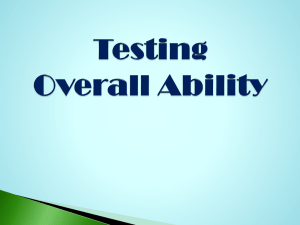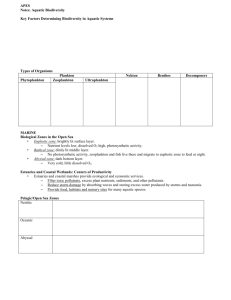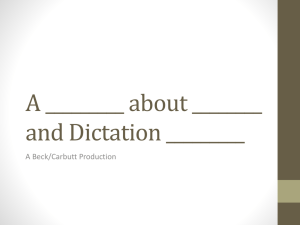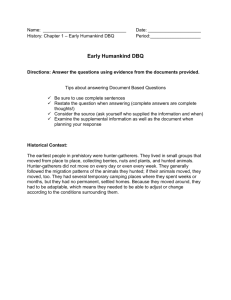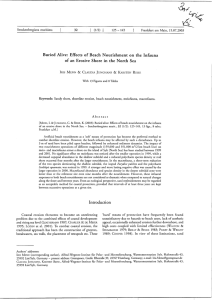Techniques for Guessing Unknown Words
advertisement
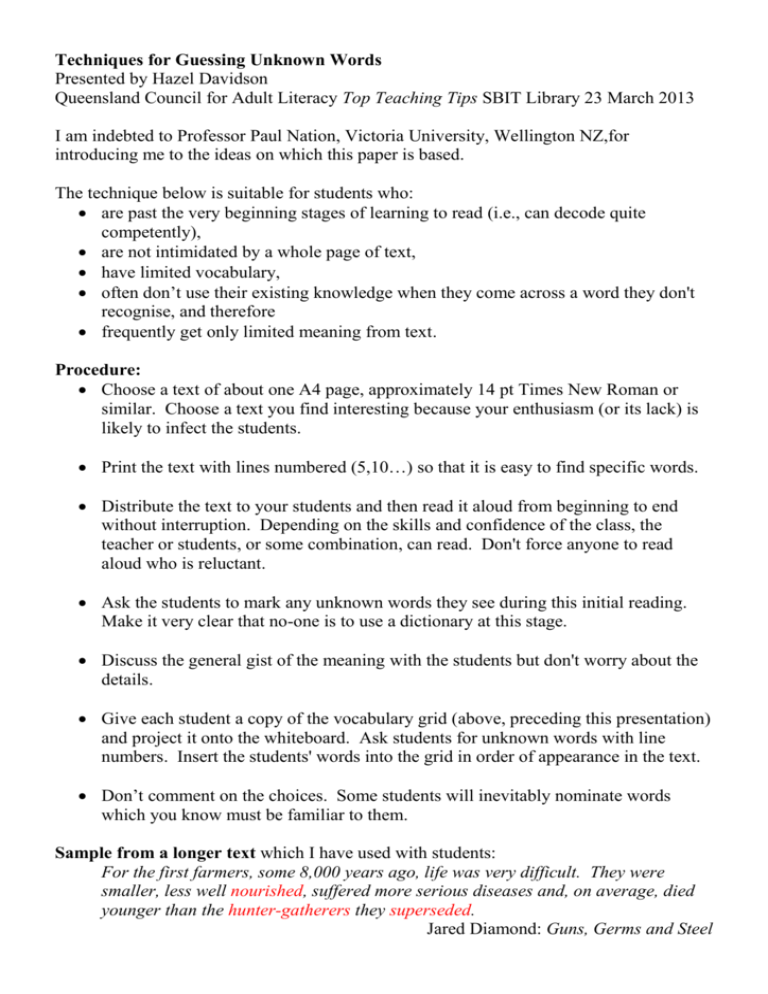
Techniques for Guessing Unknown Words Presented by Hazel Davidson Queensland Council for Adult Literacy Top Teaching Tips SBIT Library 23 March 2013 I am indebted to Professor Paul Nation, Victoria University, Wellington NZ,for introducing me to the ideas on which this paper is based. The technique below is suitable for students who: are past the very beginning stages of learning to read (i.e., can decode quite competently), are not intimidated by a whole page of text, have limited vocabulary, often don’t use their existing knowledge when they come across a word they don't recognise, and therefore frequently get only limited meaning from text. Procedure: Choose a text of about one A4 page, approximately 14 pt Times New Roman or similar. Choose a text you find interesting because your enthusiasm (or its lack) is likely to infect the students. Print the text with lines numbered (5,10…) so that it is easy to find specific words. Distribute the text to your students and then read it aloud from beginning to end without interruption. Depending on the skills and confidence of the class, the teacher or students, or some combination, can read. Don't force anyone to read aloud who is reluctant. Ask the students to mark any unknown words they see during this initial reading. Make it very clear that no-one is to use a dictionary at this stage. Discuss the general gist of the meaning with the students but don't worry about the details. Give each student a copy of the vocabulary grid (above, preceding this presentation) and project it onto the whiteboard. Ask students for unknown words with line numbers. Insert the students' words into the grid in order of appearance in the text. Don’t comment on the choices. Some students will inevitably nominate words which you know must be familiar to them. Sample from a longer text which I have used with students: For the first farmers, some 8,000 years ago, life was very difficult. They were smaller, less well nourished, suffered more serious diseases and, on average, died younger than the hunter-gatherers they superseded. Jared Diamond: Guns, Germs and Steel As examples I have marked in red some words which former students have nominated as problematic. Go through the headings on the grid with each selected word one by one. In many cases, there will be blanks under some headings. Ask the following questions: 1. Word Is this word important? Do you need to know it to understand the text? Sometimes, for example, in a list of grocery items, not knowing one item will not affect your understanding of the text as a whole. 2. Part of Speech What job does this word do in the sentence? Noun/naming word? Verb/doing word? Adjective or adverb/describing or modifying words? Conjunction/joining word? 3. Sentence Structure Is it the word: +ve/ -ve : a positive word? (something good) or a negative word? (something bad) =/u a word with the same meaning as another word in the sentence? or a word with the opposite meaning to another word in the sentence? For example, look at nourished. This is part of a sequence: smaller, more serious diseases, died younger. All of these are undesirable. So the reader would expect less well nourished to be something bad too. Less well makes nourished negative. So nourished by itself would be positive. 4. General Context What is the text about? The sentences here compare farmers with hunter-gatherers. Does that knowledge help you to understand what the word might mean? 5. Related words Do you know any other words that look or sound like this one? Look, for example, at supersede. Students will probably be familiar with super and its meanings of above, very good. They might mention superman, superior or even superlative. 6. Look at all the information across the grid. Ask the students to have a guess what the word means. In many cases they will make plausible guesses at this stage. You can confirm or refine the students’ conclusions. 7. Continue through the word list in this way. Then, when you've reached the end, go back and reread the whole text aloud. Ask the students if they understand the text better now. 8. Tell them they can look up the words in their dictionaries now or later to check the exact meaning. Consolidate: There is not much point in going to all this trouble and then allowing the students to forget all the new words they have discovered. So select some words which are potentially useful for the future and use them as a word list for exercises such as: 1. Cloze exercise (Fill in the blanks with a "list word" (Note nourished is a list word for this exercise); e.g., Free milk at school ________ every child.) 2. Synonyms and/or antonyms 3. Parts of speech in a grid: Noun Verb nourishment nourish Adjective nourished nourishing Adverb — 4. Spelling patterns Choose a few words to show the way spelling reflects pronunciation (phonics). You might, for example, look at words with er and analyse with your students which ones are unstressed, pronounced / / (e.g., teacher) and which are stressed and pronounced / / (e.g., certain). You can ask your students for more examples of each of these pronunciations of er. Discuss with them the technique of pronouncing a word slowly, with each syllable enunciated clearly, to establish the correct spelling. Then repeat the words at normal speech pace to understand the stress. This is very important so that listeners comprehend as we speak. 5. Summary notes from the text in the form of a few words, rather than whole sentences. (Students will almost invariably copy straight from the original text if you allow sentences.) If students have done this type of exercise before, you can ask them each to make their own summary. If they have not mastered this skill, do it together on the whiteboard as a class exercise. When the summaries are complete, ask each student to write his/her name on the original text, which by now will no doubt be annotated. Then collect the copies of the text. (Students keep the summary notes. Assure them that you will return their full texts later.) 6. Paragraph writing using the summary to outline the contents of the text. (This presupposes that students have already learnt how to compose a paragraph.) 7. Cloze listening exercise Make sure you remove some unstressed function words as well as some stressed content words. Replace each letter with a – to show the length of the missing words. Play a recording of the text right through. Then replay it one phrase at a time, repeating each phrase as many times as the students want, so that they can hear all the words and fill in the gaps. Then replay the whole recording straight through. Finish the exercise by returning their copies of the original text so that the students can correct the listening cloze. If you have a class with a very wide range of aural competence, you can construct listening cloze exercises at three levels of difficulty so that each student is working with an appropriate challenge. Here is the sample of text from above, followed by three levels of aural cloze. Remember that this is the culmination of the vocabulary and other work on the text so that students will be very familiar with both the content and vocabulary before they embark on the aural cloze. For the first farmers, some 8,000 years ago, life was very difficult. They were smaller, less well nourished, suffered more serious diseases and, on average, died younger than the hunter-gatherers they superseded. Easiest level: For _ _ _ first _ _ _ _ _ _ _, some 8,000 _ _ _ _ _ ago, _ _ _ _ was _ _ _ _ difficult. _ _ _ _ were _ _ _ _ _ _ _, less _ _ _ _ nourished, _ _ _ _ _ _ _ _ more _ _ _ _ _ _ _ diseases _ _ _, on _ _ _ _ _ _ _, died _ _ _ _ _ _ _ than _ _ _ hunter-gatherers _ _ _ _ superseded. Medium level: For _ _ _ _ _ _ _ _ _ _ _ _ was _ _ _ _ _ _ _ _ _ _ _ _ _ _ _, some 8,000 _ _ _ _ _ _ _ _ _ _ _ _ _ _. _ _ _ _ were _ _ _ _ _ _ _, _ _ _ _ nourished, _ _ _ _ _ _ _ _ diseases _ _ _, on _ _ _ _ _ _ _, hunter-gatherers _ _ _ _ _ _ _ _ _ _ _, _ _ _ _ _ _ _ _ _ _ _ _ _ _ _ _ _ _ than _ _ _ _ _ _ _ _ _ _ _ _ _. Hardest level (for students whose aural skills are very well developed; i.e., virtually straight transcription with an occasional word supplied as a place marker): _ _ _ _ _ _ _ _ _ _ _ _ _ _ _ _ _ _, _ _ _ _ 8,000 _ _ _ _ _ _ _ _, _ _ _ _ _ _ _ _ _ _ _ _ _ _ _ _ _ _ _ _ _ _ _ _. _ _ _ _ _ _ _ _ _ _ _, _ _ _ _ _ _ _ _ _ _ _ diseases _ _ _, _ _ _ _ _ _ _ _ _ _ _ _ _ _ _ _ _ _ _ _ _ _ _ nourished, _ _ _ _ _ _ _ _ _ _ _ _ _ _ _ _ _, _ _ _ hunter-gatherers _ _ _ _ _ _ _ _ _ _ _ _ _ _. Conclusion: By the time you have completed such a set of exercises, students will generally understand the text quite well, will have added a new group of words to their active vocabulary and be quite pleased with themselves.
